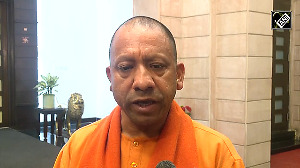Wasim Jaffer scored a fine century as India ended Day 1 in the third Test against South Africa on 254 for 3, in Cape Town on Tuesday.
The Mumbai opener scored 116 and was involved in a 153-run opening stand with new partner in Dinesh Kaarthick.
The century partnership was India's first by its openers in 12 Tests in South Africa. Vikram Rathore and Nayan Mongia had put on 97 at the Wanderers during the 1996-97 series.
Kaarthick, playing a Test after 16 months, scored 63.
Although India lost three wickets in the final session, including Jaffer, they look set for a good first innings total.
At stumps, Sachin Tendulkar and VVS Laxman were unbeaten on 27 and 4 respectively.
Morning session:
Just ahead of the first drinks break of the Test, India had reason to celebrate.
Dale Steyn banged down a bouncer outside Wasim Jaffer's off stump. The right-handed opener went across, got on top of it and pulled, fluently, wide of midwicket for four, to take India to 23/0. Cue celebrations: that was easily the best opening partnership for India in this Test series.
On a track of normal bounce and noticeably less pace than Johannesburg and Durban, the South African opening bowlers gave up early on using pace to try and hustle the batsmen. Steyn and Makhaya Ntini did try a few short balls at Jaffar, perhaps remembering his suicidal shot in the second innings at Durban. On one occasion, Jaffar mishooked, with the top edge ending up in no man's land behind Mark Boucher's back; on a few other instances, he weaved out of the way; and once each off Ntini and Steyn, he pulled to the fence.
The fact that the opener played the shot as often as he did is perhaps the best pitch report you could have: clearly, within the initial overs, Jaffar was confident this wicket did not have anything extra by way of pace and bounce. Given such conditions, he took to decisive -- and early -- movements: either fully forward to anything length or better, or quickly back and across to anything short.
Dinesh Kartick, in for Mahendra Singh Dhoni and upped to open so Virender Sehwag could bat down the order, took his own time to settle in. Unlike Jaffar, who besides the pull had played a lovely late back cut, and a backfoot punch through the covers on the rise, for boundaries, Karthick concentrated on keeping his end going, through the first hour, without playing a single shot in anger. It was only when Jacques Kallis came in for ntini (7-2-21-0) that Karthick felt good enough to glide forward, and play a nicely timed straight drive.
Earlier, Rahul Dravid had won his second key toss of the series and, as he had in Johannesburg, opted for first strike in Newlands as well. Perhaps the decision here was the easier of the two: the pitch showed up as hard and dry, the little grass there is was just so much harmless fuzz on the track, and equally importantly, the sun is blazing down -- a factor that, if it keeps up, could lead to the hard pitch cracking up as the game goes on, making batting last a very dodgy proposition.
What the Indians needed to do in the first session was ensure the South African bowlers got the message that they are in for a hard grind -- the sort of message calculated to take the edge off their aggression. Jaffar and Karthick did just that, eschewing risk early on, getting a good feel for the conditions, and being content to score only when opportunity afforded.
Of the bowlers, the only one to even remotely impress was Shaun Pollock, whose testing lines and lengths posed questions in spite of the conditions -- the three other seamers, Ntini, Steyn and Kallis, have thus far come across as monochromatic, relying solely on speed through the air, and the occasional banged-down delivery, to try and make something happen.
At lunch, India was 61-0, with Jaffer on 38 and Karthick on 22.
So far, so good -- but if India is really to capitalize on a toss that had Happy New Year written all over it in smilies, the two batsmen, and the ones to follow, will need to pick the pace up a notch or two in the two sessions to follow.
PostScript: Teamwise, India walked a fine line between choices forced on it, and choices it chose not to make. Thus, Dinesh Karthick came in for the injured Mahendra Singh Dhoni, whose fingers took a bit of a battering in the second Test; the choice also gave India the option of batting the wicket-keeper at the top of the order, in order to move Sehwag away from the pressure and into the middle order. Also, a full recovered Munaf Patel came in for VRV Singh (though Gautam Gambhir appears to have done his best to put Munaf back outside the boundary line, by stepping on his hand during practise yesterday). And the choice they did not make: Virender Sehwag got another go; Gambhir's hopes of getting a chance to prove his mettle was dashed (for some reason, though the opener was sitting in the dressing room, half his face was masked by white paint). I suspect that in picking Sehwag, the team management considered a few things: One, that he is overdue a success; two, that the wicket suits his style of play and finally, that if the track does take turn later on, his off spin provides an added option, especially when you consider the left-handers in the Proteas lineup.
For the Proteas, Kallis coming in was a given. Steyn came back into the side, too, after reporting fully fit -- and here, you might want to quibble a bit. Morne Morkel isn't as quick as Steyn, but in Durban, he bowled lines and lengths that were an approximation of Pollock's, teasing batsmen around off. Seemed to me that sort of bowling would, in these conditions, be more useful than the pure pace Steyn relied on.
Post-Lunch session
At the end of the second session, the happiest men in whites were named Anil Kumble, Zaheer Khan, Shantakumaran Sreesanth and Munaf Patel -- the four men who could afford to put their feet up and watch their opposite numbers toil on a pitch that had 'Castle Lager' etched at either end, and 'Made in India' stamped all over the middle of it.
The toss, Steve Waugh once famously said, was just a way to start a game off; his control over his team was legendary, but even his Australian attack would have given him some argument if he had lost the toss here and tried that line.
The best indication of what this pitch is all about is afforded by this wagonwheel: notice in particular the number of runs scored in the V by both batsmen, and contrast it to the total lack of runs in that area for batsmen from both sides in the two earlier games, and you get the picture of a track on which batsmen (and remember, one of them is a stopgap opener) have their driving licenses back. (Also, note on the wheel the far fewer runs scored behind the stumps, by either batsman; again, an indicator of a pitch where you don't need to edge and guide to make the bulk of your runs).
That Graeme Smith had reconciled to a long, hard grind was evident from the field set for Makhaya Ntini immediately after the break: one slip, one gully behind the bat, and five on the leg side, four of them saving runs. Clearly, South Africa's destroyer-in-chief of Durban had been reduced to a stock role after just one session, bowling on off with fingers crossed in hope. Ntini, who bowled opposite Steyn after lunch, was in fact taken off after just two overs and Shaun Pollock, so often consigned to the deep when conditions favored fast bowlers in the previous two Tests, was given the job of chipping away at the batsmen's defenses with his tighter lines and inexhaustible patience.
Pollock took to bowling from very close to the stumps, on a wicket to wicket line that was in line with Mickey Arthur's mantra of reducing run-scoring opportunities and using the pressure to try and chisel out wickets. Not that it mattered much -- Jaffar got to his 50 with a straight drive (51/114 balls, 8 fours), then closed out Pollock's first over with a neat foray onto the front foot, moving into the cover drive with lazy ease.
More signs: the four Jaffar hit to get to his 50 saw Ntini, at mid on, dive late and miss the ball; Pollock clearly signalled his anger and Ntini responded with considerable heat. In his next over, he watched as Karthick used his wrists to work one from off to leg for a single; Pollock stood mid pitch, hands on hips, yelling at his captain for a change in the field. More frustration next ball, as Jaffar rocked back and drove on the up through the covers for four.
Clearly, the heat was taking its toll on the Proteas, as India got away to the best opening partnership it has managed on South African soil, beating the previous record of Vikram Rathore and Nayan Mongia, in the second innings of the third Test of the 1996-97 series at the Wanderers.
Pollock's frustrations reached boiling point in his third over of the session: a regulation delivery, on the fullish side in length through the off corridor, saw Karthick push at it with very hard hands -- more a lapse of concentration than an indicatgion of the quality of the ball. The edge flew straight to Smith, the sole slip -- and for the second time this series, the Proteas skipper shelled a complete sitter (32/103; 95/0 at the time India).
India brought up its 100 in the 39th over -- the first century partnership on South African soil in 22 Tests going all the way back to Durban, when England put up 273 for the first wicket at Durban. The overall run rate was just 2.6; the ten overs from 29-39, after lunch, however saw the Indians scoring at about 3.9. It could have been even better (in fact, it fell away immediately after that phase) if Karthick had looked to work the ball around a bit more, and Jaffar had been a bit more proactive about running -- as opposed to ambling -- between wickets; you figured the Indian openers were missing a bet here, as a conscious effort to work singles during this phase could have added to South African frustrations.
Jacques Kallis was held back, as much because Smith couldn't risk an expensive bowler operating as to save Kallis some strain so soon after recovering from injury; Paul Harris got the ball instead and didn't shape too well, if you are a connoisseur of quality spin bowling. A very untidy action, especially at the point of delivery, saw the bowler sling it down with a bowling arm wide of his body; the trajectory was flat, and 'spin' was more notional than real. The other problem with the action is that it stops Harris from using his tremendous height, to get nip and purchase off the deck the way he would have if he was straighter and taller at delivery.
Harris' introduction to Test cricket has been surprisingly bland thus far; neither batsman went after the debutant despite conditions tailor-made for a calibrated assault.
On another note, the best indication of what this pitch is all about is afforded by this wagonwheel: notice in particular the number of runs scored in the V by both batsmen, and contrast it to the total lack of runs in that area for batsmen from both sides in the two earlier games, and you get the picture of a track on which batsmen (and remember, one of them is a stopgap opener) have their driving licenses back. (Also, note on the wheel the far fewer runs scored behind the stumps, by either batsman; again, an indicator of a pitch where you don't need to edge and guide to make the bulk of your runs).
With tea approaching, Jacques Kallis came back into the attack -- and in the pavilion, Mahendra Singh Dhoni got a good picture of his replacement, Karthick, stepping onto the front foot to flay the bowler through the covers to get to his 50 (144 balls; 5 fours). In the final over before tea, Kallis did use all his muscle to surprise Karthick, twice, with lifters that cracked the batsman, first on the grille, then on the helmet.
At tea, India had done a fairly decent job of consolidating, but it is increasingly getting to that point where you would say a team intent on winning would make an effort to build on the advantage -- 300 is an acceptable day one score on this track, anything much less actually counts as under-performance.
Tea time score: India 153/0 in 56 overs; Dinesh Karthick 63/169; Wasim Jaffer 84/170; 92 runs in 28 overs for the session.
Post-Tea session
Since none of the South African bowlers seemed likely to take a wicket, umpire Asad Rauf decided to take a hand. The first ball after tea saw Dinesh Karthick push forward at Paul Harris; the ball richocheted off the pads to Hashim Amla at silly point. The fielder collected -- not caught -- the ball and relayed it to the keeper. And up went the finger.
Umpires look for indicators -- the sound of bat hitting wood, say, or the reaction of a fielder. Here, Amla, on getting the ball in his hands instinctively threw it to the keeper, seeing Karthick out of his ground; a close-in fielder who had taken a catch would have been climbing halfway to the sky in appeal.
In any case, India lost its first wicket on the tea time score of 153/1; a disappointed Karthick walked back with a dour 63 (170 balls) to his name. The team clearly couldn't have asked for more from the stopgap opener, who with Jaffar had provided the middle order a rare platform to build on.
While Karthick's personal disappointment is understandable, the dismissal actually could have played into the team's hands. India could have sent out a free-stroking batsman, like say VVS Laxman, or Sachin Tendulkar, or even Virender Sehwag, to take toll on a tired attack at the end of a long, hard day, for instance.
Rahul Dravid, however, came out in his usual slot -- but brought with him a sense of urgency. South Africa's gameplan early in the session was clearly to use Harris to tie one end down while trying the seamers in rotation at the other end. Tactically speaking, India needed to go after Harris; that would have forced Smith to bowl two fast bowlers in tandem, and if he did that, he would have a very tired, frustrated attack to take off the field this evening; an attack, what is more, that would spend the night having nightmares of more of the same all day tomorrow.
India played largely along those lines, for a while. The 59th over saw Dravid rock back to punch Harris through midwicket; Jaffar got into the act later in the over with a copybook drive through the covers. In the bowler's next over, Jaffar rocked back, let the ball come on, and punched between midwicket and square leg for another four.
At the other end, Dravid in the 60th over twice picked off short deliveries from Steyn, through the leg side for boundaries; when the bowler altered his length in his next over, Dravid went forward into the cover drive, then stayed on top of the crease to flick to fine leg. More than those shots, though, a vicious pull Dravid played at Steyn when the bowler banged one down in frustration seemed to signal a batsman who, having drawn the short umpiring straw twice in the last Test, was hell bent on working off his frustrations.
To Smith's credit, he fought back, using field placing to help protect Harris. The bowler took to bowling a few inches outside off, letting the turn take the ball further away. Smith backed up his point and extra cover by placing a man very short on the drive in the covers -- Gibbs, in that position, kept picking up strokes that by rights should have found runs, and helped ease the pressure on the bowler. Switching Pollock on for Steyn also helped; the lines got tighter and for two batsmen who mostly play the angles dictated to them, run-scoring opportunities were reduced.
The imminence of his century also slowed Jaffar down; he finally managed the milestone with a push through midwicket off Harris when the bowler strayed to leg (197 balls, 13 fours). It was, by Jaffar's standards, an unusually dour knock; it stood out for its discipline and focus, two qualities he had failed to display in previous efforts.
Immediately after that milestone, came a point of interest for the progress of this game: Harris went around the wicket and landed one outside Jaffar's leg stump; the ball spun, Warne-style, right across the batsman and went past the off stump. That kind of turn from a rookie this early in the game is a danger signal for the home side, which will confront an Anil Kumble bowling, for once on this tour, in conditions that he will likely consider a New Year gift. Smith was quick to take advantage, putting four men around the bat, two on either side of the wicket, and backing Harris with men on the on side to choke down the runs.
Pollock's post-tea spell, in which he seemed to have gotten over the sulks of the morning, would its geometrical precision have done a Euclid proud; his tireless probing was rewarded first by a slowing down of the run-scoring, and then by a key wicket. He kept bowling around Dravid's off, adjusting the line a millimeter at a time and constantly bringing the ball in to the batsman. In the 72nd over, he finally got his man -- the umpteenth ball in the channel, but this one a fraction wider, and holding its line instead of coming in, had Dravid forward almost on auto pilot, found the faint edge and went through to Boucher (29/58; India 202/2).
Sachin Tendulkar has this thing about debutant bowlers -- he tends to make them look even more lethal than they are. With Harris bowling to him over the wicket into the rough outside leg stump, the batsman twice in one over lived dangerously, both times padding up blind and being very lucky to neither edge, nor get bowled around his back. Strange behavior, for a batsman who appears to have no issues when confronting someone of the caliber of Shane Warne. After a couple of close calls, Tendulkar reverted to playing with his bat, and immediately began looking a lot better.
With dust kicking up in increasing quantities from the rough outside the right hander's off stump, Harris began looking much better, giving the ball a healthy tweak and making it jump at the batsmen. The bowling from the rookie was interesting; even more interesting was watching the speed with which this wicket is dusting up -- at this rate, this could turn into a dustbowl by the evening of day three, making it imperative for India to focus on batting just once, and batting big.
The new ball was taken after 81 overs, by Kallis and Ntini, and while the two bowlers worked up good pace and even some bounce, the two Indians shut shop. Often, when playing predetermined defense, Sachin Tendulkar tends to commit fatal errors -- he almost did, here, when he lifted his bat out of line of a ball that was jagging back in; the ball hit the front pad and Asad Rauf had to think a long time before turning down Ntini's jack-in-the-box appeal. Rauf was right on this occasion, with Hawkeye confirming the ball was going over the stumps.
At the other end, however, Jaffar wasn't as lucky. Steyn took over from Kallis and, in a spell that was his best for the day by far, banged one down around off stump; Jaffar, who by then had thought himself into a comatose state of mind (keeping wickets in tact for tomorrow, I believe it is called) pushed gingerly at a delivery akin to the ones he had been leaving without second thoughts before; the ball sped off the edge and Kallis at second slip reacted superbly to hold one that was homing in on his nose (116/243; India 240/3). It was a very handy knock from Jaffar; the pity of it all was that adherence to 'theory', more than anything else, kept the batsman from cashing in big time.
With Tendulkar too in stumps mode, Ntini angled one in to get the edge of his defensive bat; the batsman's soft hands, however, kept the edge from going to hand, though it was touch and go. Laxman and Tendulkar saw the side home without further alarums.
The temptation would be to give the day's honors to India, but to my mind it was even. South Africa found itself on a wicket with nothing in it for the bowlers, and yet at close of play, hadn't allowed India to get completely away -- which has to qualify as a victory of sorts. By rights, India could have looked at being 300 or thereabouts with wickets in hand, leaving the home side to contemplate the prospect of a day two leather hunt followed by an impossible climb up a mountain of runs, on a pitch threatening to break up. As things are placed now, however, either side is in a position to break this game open tomorrow: India, by showing considerably more urgency than it did on day one; South Africa by prising out a couple more wickets cheap.
Close of play score: India 254/3 in 90 overs; Sachin Tendulkar 27/56; VVS Laxman 4/15; 101 runs in 34 overs for the session.







 © 2025
© 2025